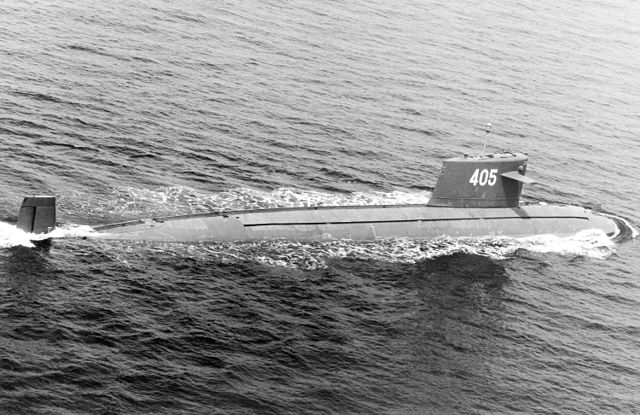
ChangZheng 5 (405) in 1993
The first Chinese SSNs: The type 091 class was nothing short of revolutionary when speaking of 1970s China. It really was a leap forward in design, technology and capability, the sign that the PLAN was now “part of the club”, which until then only comprised those with a permanent seat at the UN security council. Let’s going backwards: In 1958, July, Chairman Mao Zedong and the Central Military Commission gave approval to start the 091 submarine project. The first one, called “Long March I” (pennant number 401) was launched in 1970 and operational in 1974. Since then, five more of the same class (called Changzheng or “Long March” too) were built between 1977 and 1990. The long gap between them was linked to the capabilities of the Bohai Shipyard at Huludao but also allowed to make considerable improvements between two vessels.
It is safe to say the technological gap and capabilities between the fifth submarine, 405, and the first, now preserved at the Chinese Navy Museum, Qingdao, there was enough differences to justify a new class. As of today, China has three Type 091 in operation. Pakistan tried to procure one in 1989 and the rumor resurfaced again in 1993 and 2012. Today, the Type 093 form the ageing bulk of the Chinese SSN fleet, assumed by the Type 093 serie, and the last 091 are to be replaced by the next Type 095 in development. This goes together with a new generation of super-silent SSGs such as the Song class which caught the USN red-faced.
However the Type 091 submarine was often cited in the west, after the fall of the USSR with derision, as an example of engineering incompetence, seeing it as the world’s worst SSN. But this has to be considered in the context of the cutural revolution and technological backwardness of the time. The end result, having a working SSN in 1974, was alone actually impressive, and by itself, showed the resolve and level of commitment of the party and Chinese engineering to achieve their goals. Today’s PLAN, the world’s second largest naval force, is in debt to these men.
Development of the Han class
‘Han class’ is the NATO denomination, for convenience. It is quite significant, as the first nuclear powered Chinese submarine, and made NATO and Japan worried about the future. Peng Shilu was named as first chief designer of the 091 project. The greatest difficulty was to adapt nuclear power, developed without assistance of the USSR, to fit inside the submarine. More so, the hull was designed early on with the new “droplet-style” shown by European and USN designs, also better known as “teardrop”.
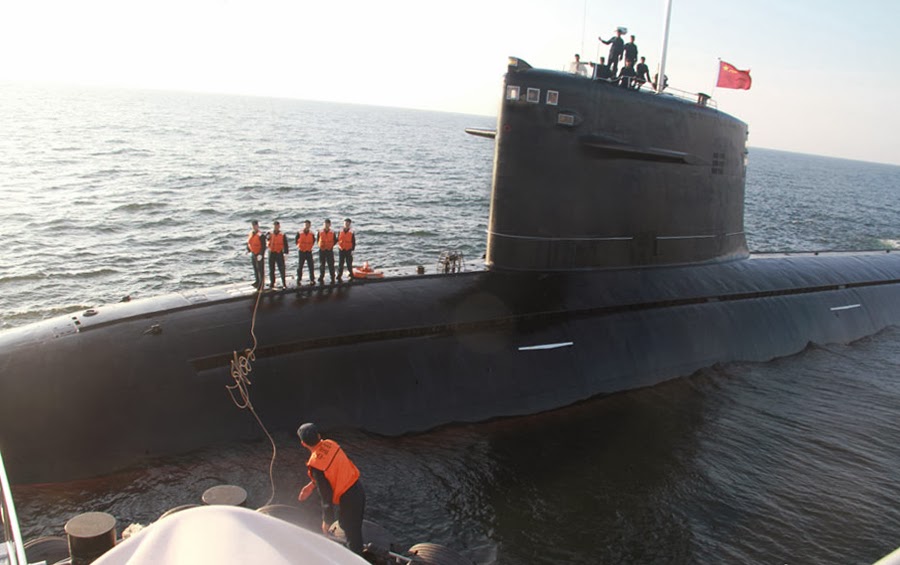
Type 091 during a review – Photo from Chinamil.cn
In 1956, China was not even close to develop its own diesel boat. Nevertheless, nuclear propulsion was targeted as a national priority by Mao himself. This was a daunting challenge in itself, compounded by Moskow’s flat refusal to any nuclear technology transfer to Beijing, despite pressing requests to share them. Official position of the USSR that it was premature for the PLAN. Even before the souring of Sino-Soviet relations, Mao claimed “We will have to build nuclear submarines even if it takes us 10,000 years.”
In July 1958, the party approved the development nuclear propulsion and ballistic missiles as well.
Decision was taken indeed in 1965 to build a land-based nuclear reactor for research and simulation, while the PLAN was submitted to a two-phase development, first a nuclear-powered attack submarine, and then a more complex nuclear-powered strategic ballistic submarine (the Type 092 Xia class, ready in 1987).
The onshore model reactor started trial operation in May 1970. It ran an open test and succeeded in all objectives. By July, the nuclear submarine project staff members held a meeting, changing the schedules and on July 26, a steam turbine generator started operations, a first for the country. By December 26, 1970 (Mao Zedong’s 77th birthday) saw the launch of the Long March I, a national event. The submarine design went on along the development of the reactor plant. The reactor was in place by early 1971 and started operations in April 1971 in the dock. On August 17, Zhou Enlai approved sea trials.
The first test was performed at sea on August 23, 1971, revealing numerous issues. Tests ended in 1974 as the submarine was officially scheduled to join the fleet. Nearly 200 tests has been carried out, paving the way to modify the newt boats. The reactor worked for thousands of hours, the submarine covering 6,000 nautical miles in order to complete an exhausting data coverage. The last tests were performed with Den Xiaoping on board
Impact of the Cultural revolution 1969-79
The Type 091 development went through one of the most rocky and violent period of Chinese History since 1949: Three years of natural disasters, ten years of cultural revolution. The basic goal was to develop a submarine at least at the same level as the Soviet Union’s own SSNs but there was still a considerable gap (thermal performance, quietness, reliability) with the west. In 1970 however, despite all odds, the Chinese were able to develop without assistance an integrated sound sonar, lightning detectors, sound trajectory, reconnaissance sonar and underwater sound detection systems despite the limited technological and manufacturing capacities of the local industry. As a result, the Type 091 in its first version in the 1970s was a few steps below Western equivalents in terms of performance in particular for water sound detection and noise levels reduction.
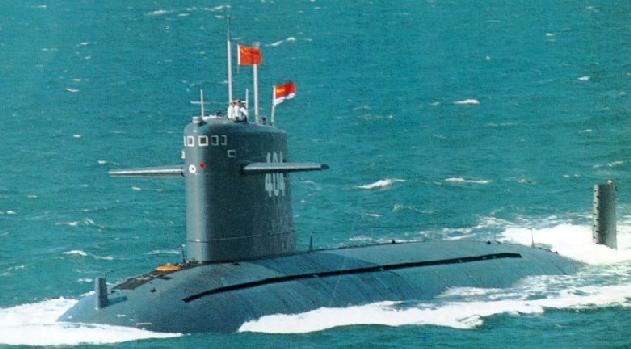
Han class, 404
The armaments also suffered from the chaos and purges of the cultural revolution: The fish-3 torpedo for example, a new generation of acoustic deep-water-capable submarine-killer torpedo was developed in 1972. But the project dragged on until October 1983, with further tests in 1984. The fish-4 torpedo development started from December 1982. As a result, it would be only available for the next three Type 091 submarines, retrofitted later, as many other systems. But in 1974, Long March I was to enter service with the same standard torpedoes used by the other diesel submarine classes in service in the PLAN.
Ongoing tests until 1988
Deep-diving and underwater great speeds were tested, as well as great depth torpedo launchings were not completed until April-May 1988. Therefore despite being launched as early as 1970, it would take almost 15 years of R&D to see the first two SSNs fully operational. This lost decade was attributed to the turmoil of the Cultural Revolution. Searchers, chief engineers and program directors indeed were detained and ‘reeducated’, hampering China’s nuclear submarines progress for years.
Delays also added pressure on completing al required sub-systems, causing in the end backward performances due the lack of refinment of these technologies, prssure from the party to press the Type 091 in service prematurely. This was very much a prestige program as well. After all, the first French Rubis class SSN was only launched in 1979, some nine years after the Chinese SSN, but without any political interference and having access to more advanced western technology.
The end result: More than a SSN program
The Type 091 in the end solved the need for SSNs as expressed by Chairman Mao, and significantly improved China’s defense industry research and development capabilities. Manufacturing and repair capabilities as well as modern navigation, targeting, torpedo tech, communications or underwater acoustics, radar and sonar tech were all considerably improved and also benefited the classis Ming class SSGs as well. This allowed despite all odds, China to advance alone to a new level, layind solid fundations the PLAN to develop a shift from conventional submarines, as well as ballistic missile technology, enabling the country the most efficient form of deterrence and paving the way for further SSNs classes.
Construction
The Huludao-based, brand new Bohai facility of the 1954 shipyard was chosen. The first Type 091, Long March I, was laid down in 1967 in a great ceremony. Now called Bohai Shipbuilding Heavy Industry Co., Ltd., the yard has been responsible of all Chinese nuclear-powered submarines ever since. It is a subsidiary of China Shipbuilding Industry Corporation (CSIC), located in southwestern Liaoning Province, facing the Bohai sea. Bohai Shipyard was a game changer for China’s nuclear powered submarine program and in late 2016, the yard completed a new 40,000 square metres (430,000 sq ft) covered shipbuilding facility. This would help deliver submarine faster, by all seasons. It is speculated modular construction is also widespread and the space available is enough to built four SSBN at once.
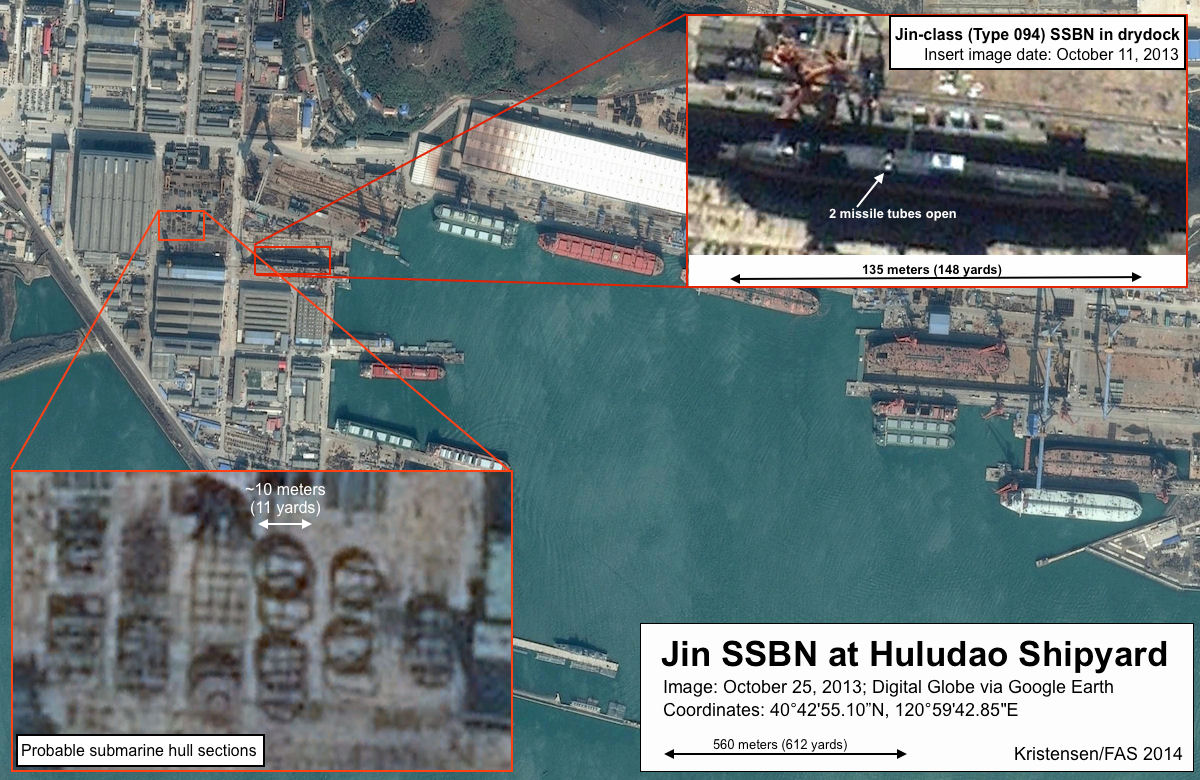
Global-Security FAS satellite photo and recognition of the nuclear submarine facilities
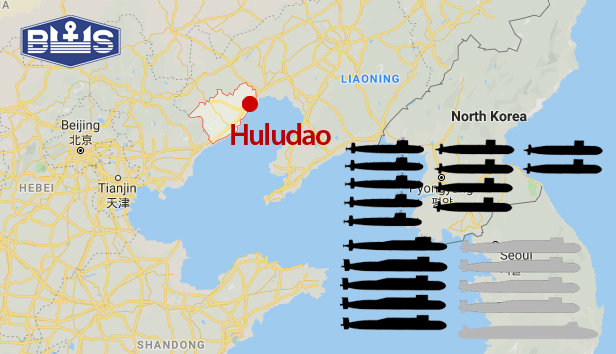
The Bohai shipyards are already responsible for the replacements of the type 091, Type 095, the five 091 and six 093 SSNs (Song class), plus the 092 (Xia class) and four 095 (Jin class) plus four more and the Type 98 SSBN planned for 2025.
The ‘Long March I’ was largely experimental and was merely a scientific research platform shaped as a SSN, by the National Defense Science and Technology Commission. At first there was no identified associated and the project was temporarily named as the “No. 1701″ nuclear submarine. However nomenclature had it attached to the submarine lineage as a”09 Project”. The “9” prefix meaning nuclear power while the “3” designated traditional diesel-powered submarines. By August 1, 1974, the submarine was at last officially named in a ceremony held on the bank of Bohai Bay. Navy Commander Xiao Jinguang, read the order of the Central Military Commission, naming officially the submarine “Long March number one” (ChangZheng-1) which was added to its navy flag.
As soon as it was spotted by Western intelligence, the new submarine had to be registered in NATO nomenclature. Like previous ones, it was named after a Chinese dynasty. “Han” by chosen by the US Department of Defense Intelligence Agency. The Han dynasty ruled from 206 B.C.-A.D. 220, at a time immortalized by the grand Chinese national epic, “the Romance of the Three Kingdoms”.
Design of the Type 091
The Type 091 is designed with a total of 7 compartments, also built modules.
-First: Torpedo room
-Second: Command module
-Third: Front auxiliary compartment, emergency power
-Fourth: Nuclear reactor, control and shielding
-Fifth: Control room and auxiliary engines.
-Sixth: Main engine compartment, propeller shaft
-Seventh compartment: Tail and stern electronics.
Fully loaded displacement is about 5,500 tons, armament consists of six 533mm bow torpedo tubes. The streamlined teardrop hull* (a first compared to usual Chinese diesel submarines) was 98 m (321 ft 6 in), by 10 m (32 ft 10 in) in diameter including the pressure hull, and a draft of 7.4 m (24 ft 3 in). It was propelled by a single Nuclear turbo-electric engine fed by a pressurized water reactor. This unit was able to provide the boat a top speed of 25 knots (46 km/h), for an unlimited range and the boat was served by a crew of 75.
*A nice story by China Times reported that Huang Xuhua claimed he developed the Type 091 hull from two toy submarines imported from the United States and Hong Kong. Of course it was very unlikely this was a substitute for years of hydrodynamic research
The hull is a double-shell structure, which had a large reserve buoyancy, with high damage resistance and anti-sismic property (for deep charge blasts). The adjustment ballast tanks with the buoyancy adjustment control, as well as the fuel oil tank and the intake/exhaust piping systems are all placed between the two shells. The pressure-resistant shell and the non-pressure-resistant shell are soaked with water, to ensure remaining water between the two flows out in time when the submarine floats up.
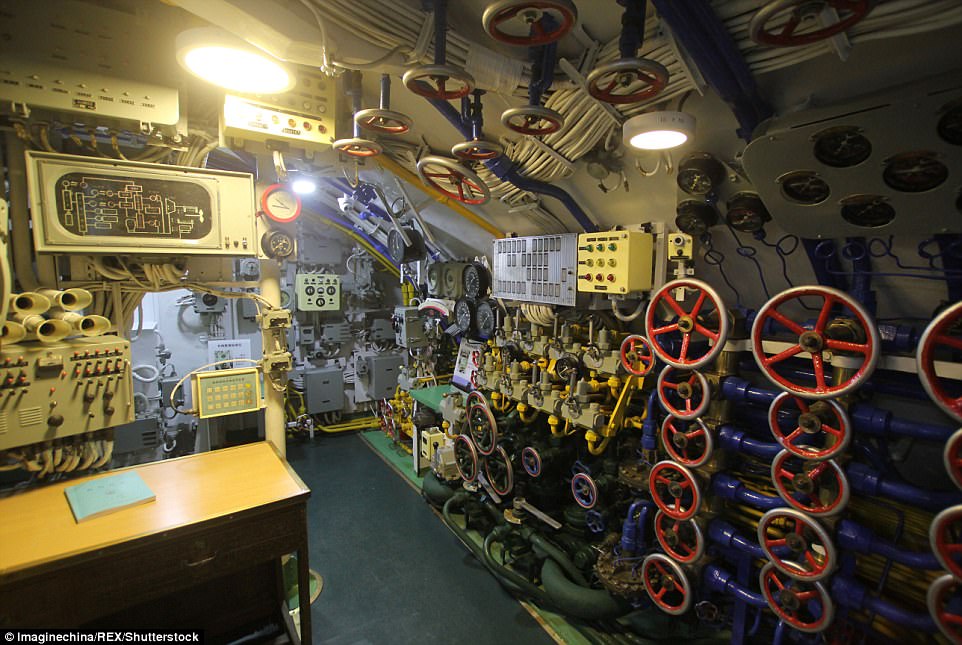
Interior view of the command station, Type 091 Long March I exposed at Qindao – credits imagedchina REX Shutterstock
Propulsion of the Type 091
The propulsion rested on a 90 MW pressurized water reactor with a primary loop system. It was filled with very hot and high-pressure pure water, classic core and a control rod. The loop comprised a circulation pump with a voltage regulator and steam generator. There was also a rear auxiliary engine with backup secondary circuit system, driving auxiliary equipment, composed of a steam turbine generator set with a condenser.
Although the structure is complex, it is not limited by the working depth, the launching noise is small, and no bubble is exposed to the position of the submarine. High-pressure gas operated by the pneumatic launch was not in closed loop, so to avoid any accident. Top speed of the Type095 was 12 knots on surface, 25 knots underwater, which was a far cry of the 33 knots of the November or 40+ knots of the Alfa. Working immersion depth was 300 m. Devoid of any measure for quiet internal assembly for the turbogenerators, the type 091 was estimated 2.68 times noiser than the Los Angeles-class SSNs.
Post 403 modifications
After largely experimental 401 and 402, the PLAN ordered a serie of improvements and upgrades to fix all the limitations and problems reported. To reduce the noise level, anechoic tiles were used to cover several devices and Long March 3-5 were considered 20% quieter, from 160-170 decibels originally to about 140-150 decibels. This was still way above western submarines, but the real target for the party were Soviet submarines. All in all, development was ongoing for 21 years.
1992-96 09-I Upgrade
The “09-I” upgrade project of the 1990s was aimed at using improved anechoic tiles while the hull’s shape was improved, longitudinal flow and the adoption of a row of square holes with a gap and a newly designed integrated sonar. The latter adopted advanced technologies such as Kalman filtering, adaptive noise cancellation and optimal linear prediction. The new system indeed provided a torpedo alarm, enabled a multi-target automatic tracking and also low-frequency line spectrum detection, a radical increase in environmental battle awareness.
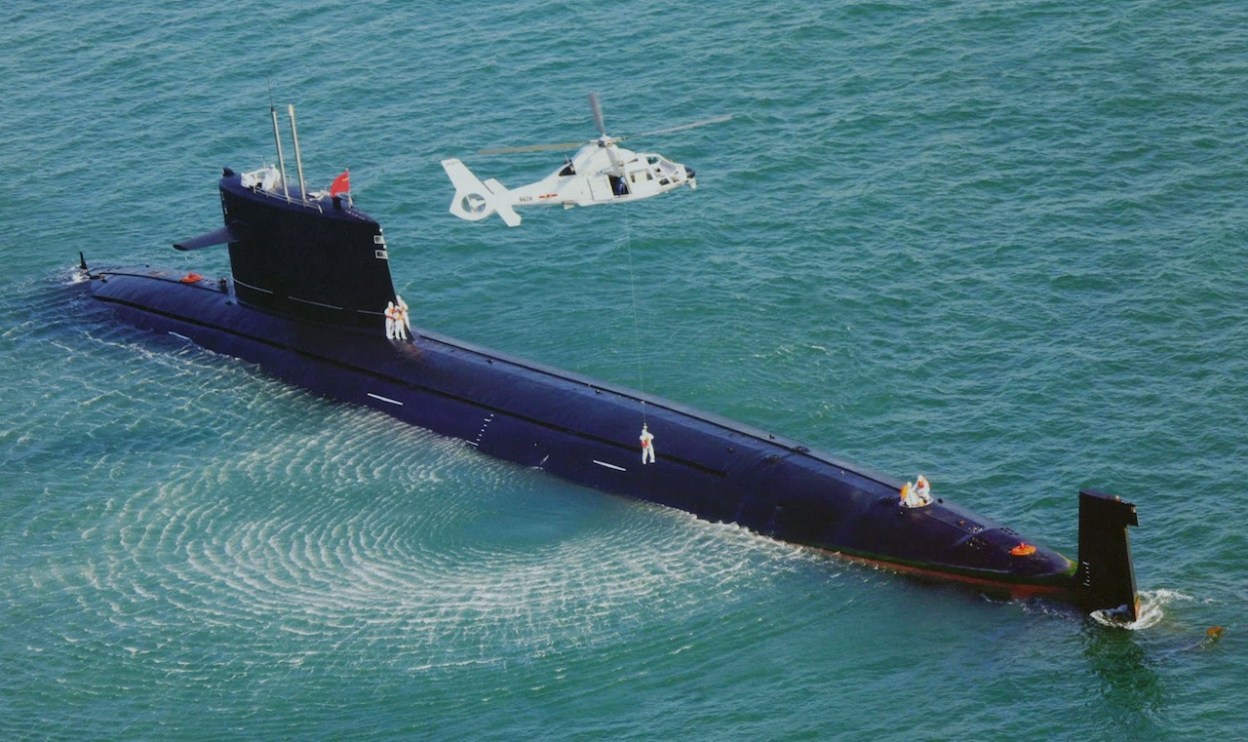
Type 091 Han class and Harbin helicopter during a personal transit onboard – credits sinodefence.com
Armament
The Type 091 was armed with standard torpedoes and can also lay sea mines through the same tubes, some 36 mines (or Russian and foreign mines). To precise these six 533 mm (21 in) torpedo tubes were provided with 20 torpedoes. These tubes can also fire Russian torpedoes or even NATO models as they use a standard caliber. Fish-1 torpedoes were carried by 401, fish-3 torpedoes from 402. They were fired using a hydraulic balance launching system. In greater working depth, the launching noise is reduced whereas producing no bubbles. The high-pressure gas produced by the pneumatic launch is evacuated harmlessly.
Chinese Torpedoes:
-The Yu-1: (Litt. “fish”) A first-gen. steam-powered torpedo based on 1950s unguided Soviet ASuW Type 53 torpedo. It was in service from 1971 and also purchased by Romania. It was capable of a range of 3.5 km at 50 knots, up to 9 km at 39 knots and was guided by a straight running gyroscopic system upgraded to a passive acoustic homing in the late 1970s. Note: the Yu-2 which was developed earlier was a small, 450 mm, 70 knots propelled by a rocket and guided by passive acoustic homing.
-Yu-3 (1984): Proper submarine torpedo, developed from 1965, after the Sino-Soviet split, by the 705th Research Institute. It is guided with active/passive acoustic homing, with a range of 13 km, a top speed of 35 kt and was able to dive down to 400 metre for ASW warfare.
-Yu-4: Developed from the Russian SAET-50 ASuW passive acoustic homing torpedo, in service in 1987. Eelectric propulsion, range of 6 km at 30 knots (56 km/h) up to 15 km (upgraded) at 40 knots (74 km/h). It has been upgraded several times and is still in service.
-Yu-5: A tailored, specialized ASW torpedo. Wire-guided and a copy of the Russian TEST-71 torpedo. It entered service in 1989, but only on conventional diesel-electric submarines.
-Yu-6: This is the Chinese equivalent of a Mark 48 torpedo, reverse engineered in the 1980s. It was operational and introduced from 2006, propelled by Otto Fuel II, with a range of 45 kilometres (28 mi), able to speed up to 65 kt, and using a passive/active acoustic homing + wake homing + wire guidance systems. It is likely used by the 403-405 today, alongside older stocks of the Yu-3.
Submarine-launched Missiles
From No. 403 onwards, a missile launcher was installed, in a widened section after the command post and conning tower, under traps. The tubes are versatile, they can launch the C-801 or ‘Eagle-82’ anti-ship missile, but in both case, only on the surface, a serious drawback.
The YJ-8 (鹰击-8 – yingji-8 /NATO CSS-N-4 Sardine) is a Chinese surface-launched subsonic anti-ship cruise missile manufactured by the China Aerospace Science and Industry Corporation (CASIC) Third Academy. This is a solid rocket with an operational range of 42 km, a flight altitude of 5-7 m, a top speed of Mach 0.9, an Inertial navigation/active radar homing terminal guidance. It is a heavily modified copy of the MM38 Exocet.
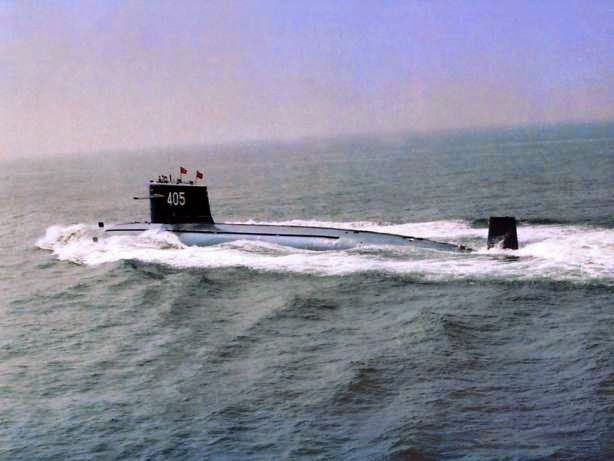
Captors
The 403 seems to have received French Thomson-Sintra DUUX-5 passive sonars, purchased before the post–Tiananmen Square arms embargo. This sonar can track up to three targets simultaneously. This sonar system is an intermediate frequency passive search and attack model, with a large array technology, digital scanning display for track multiple targets and coordinating attacks. It is fitted in the lower pressure-resistant casing of the torpedo launching port. It is accepting a transducer matrix sonar array using hundreds of sonar transducers.
The Type 091 is also fitted with an IF communication sonar and hydroacoustic interference equipment, for underwater communication, but also enemy identification (IFF) but also cooperative ranging. Its range is about 5-10 nautical miles, with a notification distance of 15 nautical miles, identification about 4 nautical miles. Supplementary arrays are fitted on both sides, whereas three white collision lines were painted (see the profiles) to precisely calibrate the installation position of the sonar array to improve its detection accuracy and tracking capabilities.
The electronic equipment also includes a multi-purpose combat data and command systems. Above the conning tower, alongside the snorkel, attack periscope and airborne periscopes and inertial navigation masts, there is an I-band search radar and a 921-A radar warning system. The communication antenna is using a short wave, with an ultrashort wave transceiver, and a very long wave receiver. Alongside there is also a satellite communication system. The hull is also equipped with an integrated air conditioning system. From the 403 serie, an anti-ship missile fire control system was installed.
Operational Service
As it was already said, all five boats entered service along a 21-year span, which is a record one for a submarine class.
The 401 was launched on 1970 and completed in 1974 to be preserved at the Chinese Navy Museum, Qingdao, without its reactor.
The 402 was launched in 1977 and was operational in 1980, to be retired in 2004 and decommissioned (and scrapped afterwards).
The next-gen, larger 403 was launched in 1983 and completed in 1984, so much faster, the 404 in 1987 and completed in 1988, and the 405 launched in 1990 and completed by 1991.
All five units were initially deployed with the North Sea Fleet, and their homeport was Lushan. The decision to base them all together was probably motivated by logistical reasons, as these early boats still requiring fixes and a relatively high level of maintainenance, was made easier at a single facility. The other reason might have been motivated by the proximity of the Soviet Union, considered a much more serious threat. Since then, they have been moved with the south China fleet.
Li Jie, a military expert based in Peking, claimed that if the Type 091s were ‘about 20 years behind US boats’, they still can cause shivers to USN task force commanders. Indeed during the 1996 Taiwan Strait crisis, two Type 091 submarines tailed the aircraft carriers USS Independence and USS Abraham Lincoln. They were of course heard and localized, but their presence nevertheless pushed the US carriers 200 miles away from the Island by their simple presence.
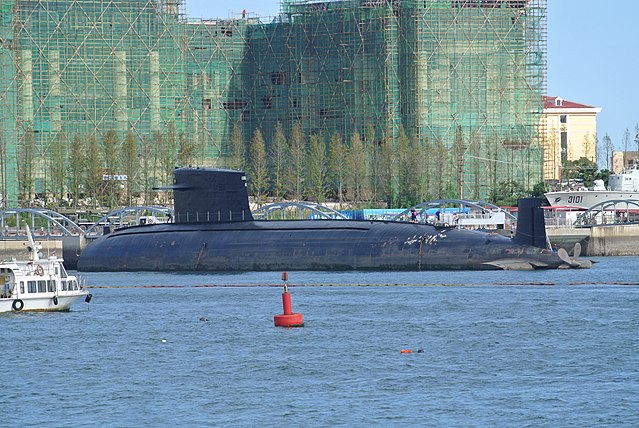
Han class submarines – another view
Unbelievable Noise levels and other issues
In March 2007 Seapower Magazine published an article based on an US Office of Naval Intelligence (ONI) report from December 2006 under the Freedom of Information Act. According to this, the Han class were particularly noisy submarines based on 1960s technology, and despite several upgrade programs, it remains also limited in weaponry range. So it was in the 1980s a backwards design with poor offense and defence capabilities.
The lead boats (401 & 402) suffered acute radiation problems only solved after extensive refit.
Despite of this, these SSNs underwent many exercises and trials: On 27 October 1994, 100 km west of Kyushu, an unidentified Han-class shadowed the USS Kitty Hawk (CV 63) battle group. It was tracked by an S-3B ASW aircraft from Kitty Hawk all along the Korean coast as reported. The fight came too close for comfort as apparently several Chinese J-6 fighters scrambled to intercept the S-3 aircraft the next day. At the closest, the Han-class stayed at 30-km of the Kitty Hawk, much closer than in battlegroup normal procedures.
After the 1990s, two of the Han-class were transferred to the Chinese Navy’s South China Sea Fleet, strengthening the PLAN presence against in the South China Sea and near Taiwan. In the 1996 Taiwan Strait crisis one was tracked by U.S. military satellites but apparently the presence scared the task force and force it to stay within 200 nautical miles of Taiwan.
-On 10 November 2004 another Han-class spent two hours submerged in Japanese waters, entering the Pacific Ocean in Japanese territorial waters, southwestern sector of Okinawa prefecture. It was believed to enter between Miyako and Ishigaki islands at 10 knots, cruising in shallow waters, 300 meters below the surface. It was easily heard by the JSDNF and prompted Japan’s naval forces to react. The submarine was chased with destroyers and a patrol plane as it went back to Chinese waters. It was also later shadowed by P-3C Orion aircraft. The whole affair spanned several days.
-On 16 November, China, caught red handed, officially expressed regrets as reported by Japan’s Foreign Ministry. China excuse was to say it was a training mission and went off course because of a “technical faliure”. It was also possibly linked to gas exploration in a remote island area claimed by both countries, the Senkaku/Diaoyu, although they were about 500 kilometers from Japan’s Okinawa Island.
Recent service
Since the late 1990s the first two boats were apparently mothballed as shown by satellite photos, no longer operational. According to some reports in 2000, only the last two of the Han-class SSNs were operational despite an accumulation of extended refits. Reports of their service until late 2003 was nevertheless confirmed by the PLAN.
In 2009, 403 was publicly unveiled at the 60th anniversary of the Chinese Navy. Her sisters 404 and 405 remained in service as of 2019 and the US Department of Defense’s Annual Report 2006-2007 reported a PLAN nuclear sub force of 5 vessels including one SSBN, one Type 093 (Shang class) leaving three Type 091 Han boats. A report from 29 October 2013 confirmed the end of the secured decontamination of 501 to be used as an exhibit at Qindao.
In 2014, one was spotted in a port visit to Colombo, Sri Lanka. In 2015, one of these boats accompanied China’s fleet rotation dedicated to anti-piracy tour of service on the Horn of Africa, and eight thousand miles long trip, the longest ever observed for a Chinese nuclear submarine. This proved that despite the long span of modifications and early teething problems, the Type 091 class is now reliable. The last three are scheduled to be retired when the 095 entering service in the late 2020s.
In October 2017, China Daily reported the conversion of “Long March I” in Qingdao as a permanent exhibit. To perform this and avoid any problem with the public, the reactor and all nuclear material have been removed and the ship thoroughly decontaminated.
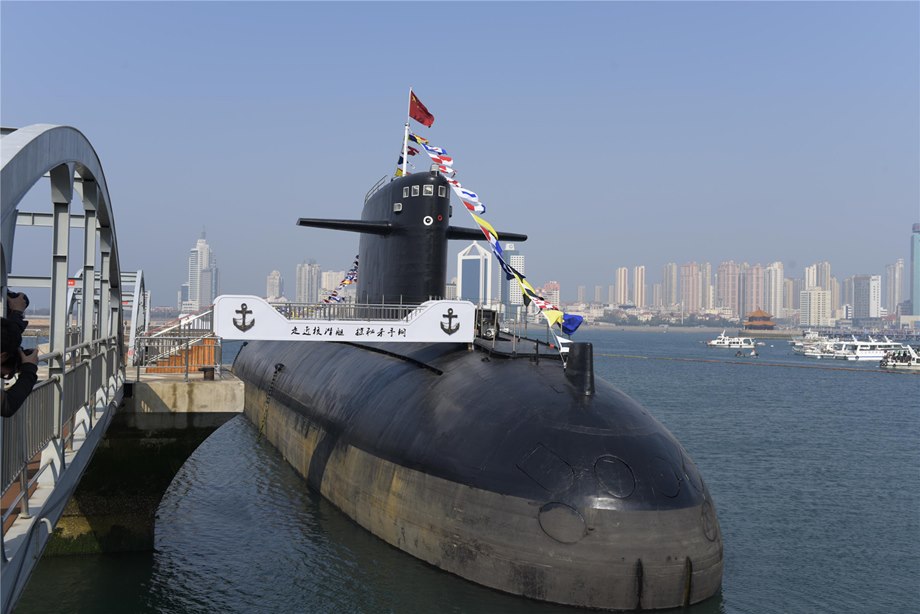
The Long March I preserved at Qindao, Credits sinodefence.com
Pakistan’s attempted purchase
In 1989, Pakistan made an abortive attempt to pucrhase a Type 091 boat for USD$63 million to the Chinese government. The decision was taken as a response to the Soviet K-43 announced leased to India in 1988. There has been since rumours of a renewed interest by Karachi to purchase one of these boats, perhaps the deactivated 502 before 2012. However otherwise for training the already obsolete platform could have only served for reverse engineering and officially training. The deal was not provoked by Pakistant but the single Han-class nuclear submarine was offered by China, examined but rejected by the PLAN due to noise control issues. It competed with a cheaper and quieter Ming class. This was an alternative to the procurements of new submarines which led to the infamous “Agosta affair”.
Indeed, despite intelligence services all agree on the reality that Pakistan has now nuclear weaponry, neither the latter or India has any SSN or SSBN in service and under international pressure and without further degradation of relations in the region, unlikely to evolve. Pakistan acquiring a SSN would for sure trigger a reaction of all neighbours. It must be recalled that India possessed a class of ballistic nuclear submarine, called Ahirant, since 2015, not Pakistan. On the other hand Japan possessed neither any SSN or SSBN.
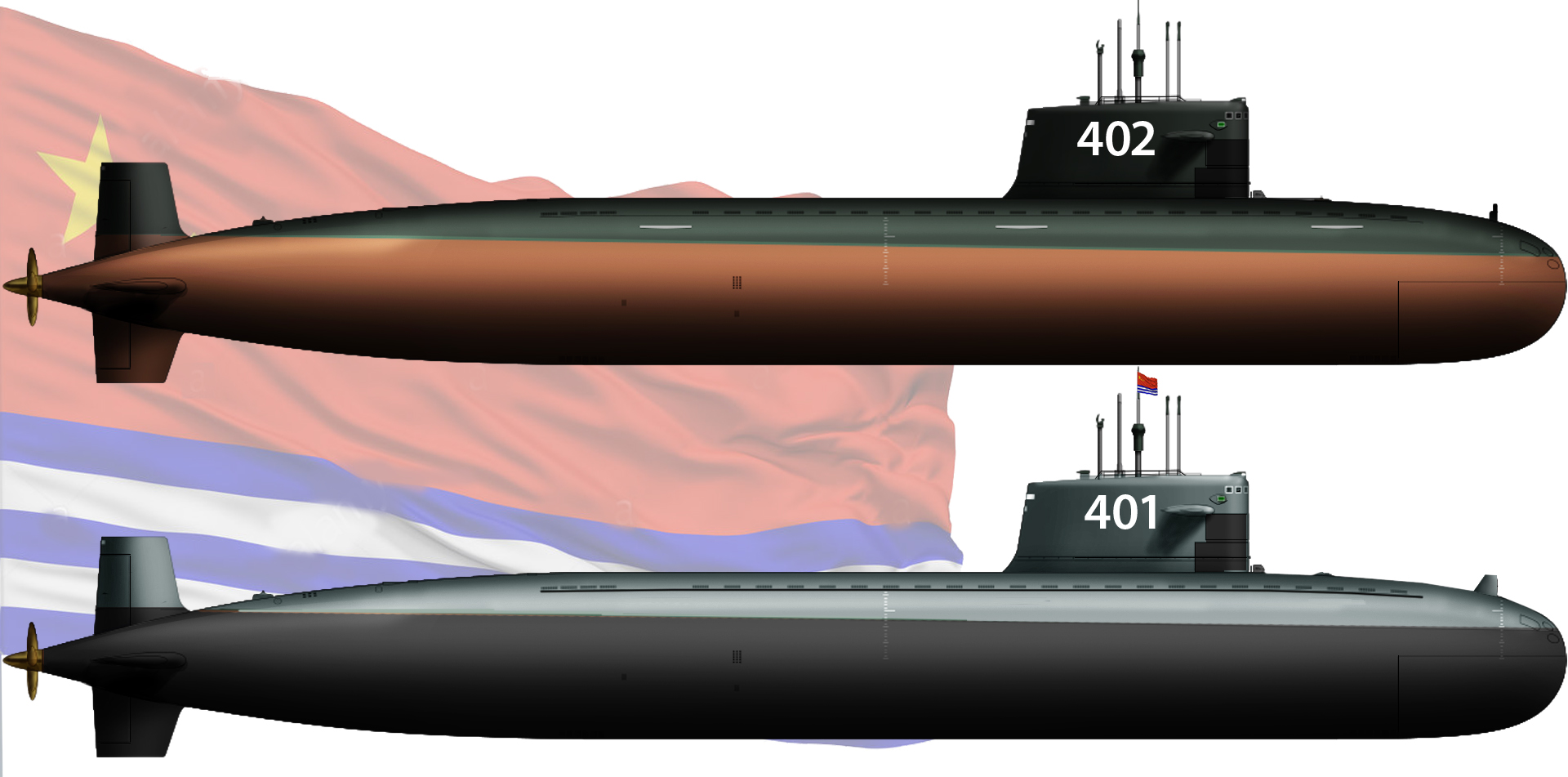
Author’s rendition of the 402 and 401 in their respective livery, 1978 and 1985. Based on profiles of Mike1979 Russia 1991 under wikimedia CC licence. Free to share.
Read More/Src
//www.globalsecurity.org/military/world/china/newcon-ss.htm
//www.popularmechanics.com/military/navy-ships/a26201/china-building-the-worlds-largest-submarine-factory/
//www.globalsecurity.org/military/world/china/type-91.htm
//sinodefence.com/type091_han-class/
//www.military-today.com/navy/han_class.htm
//atomic-age.fandom.com/wiki/Type_091_Han_class_submarine
//zh.wikipedia.org/wiki/09I%E5%9E%8B%E6%A0%B8%E6%BD%9C%E8%89%87
//ship.bsu.by/ship/103188
//www.navalanalyses.com/2018/04/infographics-31-peoples-liberation-army.html
//www.chinadaily.com.cn/china/2017-04/25/content_29073327.htm
//en.wikipedia.org/wiki/Type_091_submarine
//web.archive.org/web/20060614012240/http://www.sinodefence.com/navy/sub/035.asp
//web.archive.org/web/20060709084621/http://www.china-defense.com/naval/wuhan351/wuhan351.html
//www.janes.com/article/31886/bangladesh-reported-to-have-signed-submarine-deal-with-china
Modeller’s Corner: Hobby Boss Type 035 Ming
http://cmano-db.com/submarine/China/
http://gentleseas.blogspot.com/2013/12/china-selling-two-type-035-ming-class.html
Ming class 3D on turbosquid.com
Han class model Kits:
http://cs.finescale.com/fsm/modeling_subjects/f/7/t/153078.aspx
https://military.scale-model-kits.com/products/PLAN-Type-091-Han-Class-SSN-HB83512.html



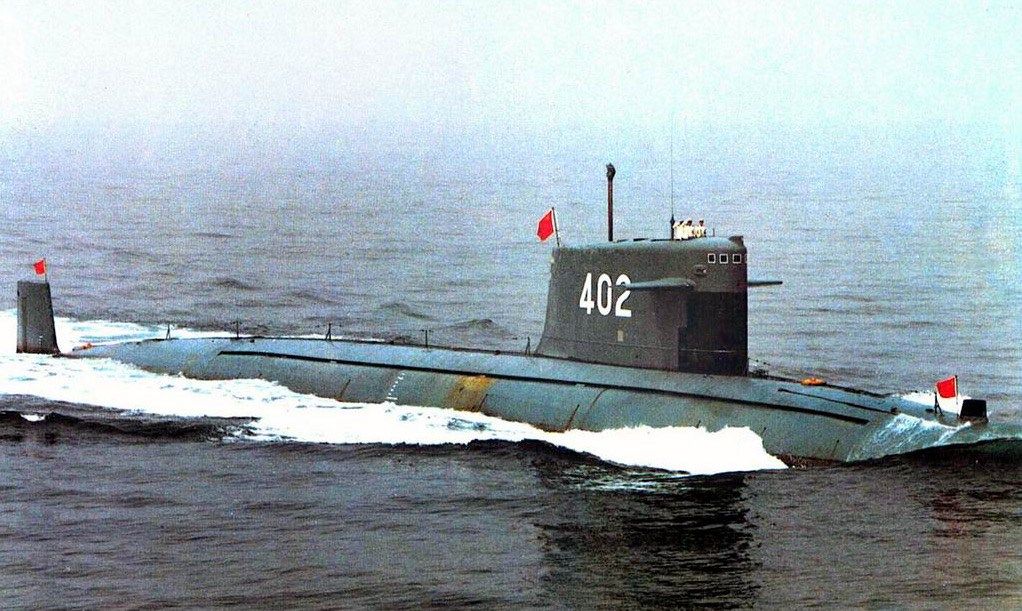
 Latest Facebook Entry -
Latest Facebook Entry -  X(Tweeter) Naval Encyclopedia's deck archive
X(Tweeter) Naval Encyclopedia's deck archive Instagram (@navalencyc)
Instagram (@navalencyc)





 French Navy
French Navy Royal Navy
Royal Navy Russian Navy
Russian Navy Armada Espanola
Armada Espanola Austrian Navy
Austrian Navy K.u.K. Kriegsmarine
K.u.K. Kriegsmarine Dansk Marine
Dansk Marine Nautiko Hellenon
Nautiko Hellenon Koninklije Marine 1870
Koninklije Marine 1870 Marinha do Brasil
Marinha do Brasil Osmanlı Donanması
Osmanlı Donanması Marina Do Peru
Marina Do Peru Marinha do Portugal
Marinha do Portugal Regia Marina 1870
Regia Marina 1870 Nihhon Kaigun 1870
Nihhon Kaigun 1870 Preußische Marine 1870
Preußische Marine 1870 Russkiy Flot 1870
Russkiy Flot 1870 Svenska marinen
Svenska marinen Søværnet
Søværnet Union Navy
Union Navy Confederate Navy
Confederate Navy Armada de Argentina
Armada de Argentina Imperial Chinese Navy
Imperial Chinese Navy Marinha do Portugal
Marinha do Portugal Mexico
Mexico Kaiserliche Marine
Kaiserliche Marine 1898 US Navy
1898 US Navy Sovietskiy Flot
Sovietskiy Flot Royal Canadian Navy
Royal Canadian Navy Royal Australian Navy
Royal Australian Navy RNZN Fleet
RNZN Fleet Chinese Navy 1937
Chinese Navy 1937 Kriegsmarine
Kriegsmarine Chilean Navy
Chilean Navy Danish Navy
Danish Navy Finnish Navy
Finnish Navy Hellenic Navy
Hellenic Navy Polish Navy
Polish Navy Romanian Navy
Romanian Navy Turkish Navy
Turkish Navy Royal Yugoslav Navy
Royal Yugoslav Navy Royal Thai Navy
Royal Thai Navy Minor Navies
Minor Navies Albania
Albania Austria
Austria Belgium
Belgium Columbia
Columbia Costa Rica
Costa Rica Cuba
Cuba Czechoslovakia
Czechoslovakia Dominican Republic
Dominican Republic Haiti
Haiti Hungary
Hungary Honduras
Honduras Estonia
Estonia Iceland
Iceland Eire
Eire Equador
Equador Iran
Iran Iraq
Iraq Latvia
Latvia Liberia
Liberia Lithuania
Lithuania Mandchukuo
Mandchukuo Morocco
Morocco Nicaragua
Nicaragua Persia
Persia San Salvador
San Salvador Sarawak
Sarawak Uruguay
Uruguay Venezuela
Venezuela Zanzibar
Zanzibar Warsaw Pact Navies
Warsaw Pact Navies Bulgaria
Bulgaria Hungary
Hungary

 Bundesmarine
Bundesmarine Dutch Navy
Dutch Navy Hellenic Navy
Hellenic Navy Marina Militare
Marina Militare Yugoslav Navy
Yugoslav Navy Chinese Navy
Chinese Navy Indian Navy
Indian Navy Indonesian Navy
Indonesian Navy JMSDF
JMSDF North Korean Navy
North Korean Navy Pakistani Navy
Pakistani Navy Philippines Navy
Philippines Navy ROKN
ROKN Rep. of Singapore Navy
Rep. of Singapore Navy Taiwanese Navy
Taiwanese Navy IDF Navy
IDF Navy Saudi Navy
Saudi Navy Royal New Zealand Navy
Royal New Zealand Navy Egyptian Navy
Egyptian Navy South African Navy
South African Navy






























 Ukrainian Navy
Ukrainian Navy dbodesign
dbodesign